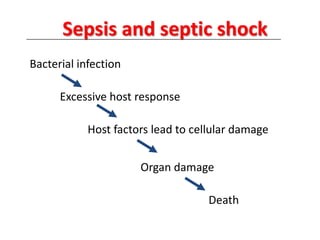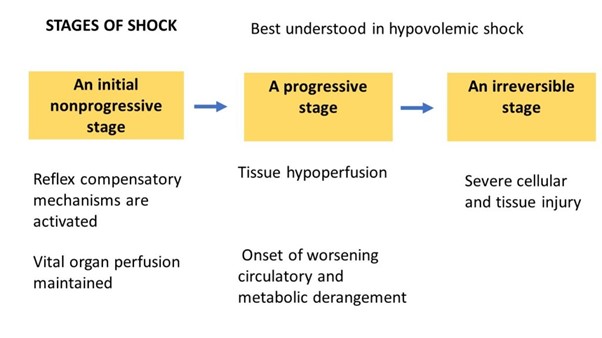When caring for a patient weighing 60 kg who has just been admitted with septic shock, which of these assessment data greatest concern to the nurse?
Arterial oxygen saturation is 90%.
Urine output 15 ml for 2 hours.
Apical pulse 110 beats/min.
BP 94/56 mm Hg.
The Correct Answer is D
Septic shock is a life-threatening condition characterized by severe infection, systemic inflammation, and inadequate tissue perfusion. Hypotension, as indicated by a low blood pressure reading, is a significant concern in septic shock. It reflects inadequate perfusion to vital organs and tissues, leading to potential organ dysfunction and damage.
While all the assessment data provided may be important and require attention, the low blood pressure (BP) reading indicates impaired systemic perfusion and can contribute to end-organ damage. The nurse should prioritize interventions aimed at improving perfusion and stabilizing the patient's blood pressure.
A. Arterial oxygen saturation is 90% in (option A) is incorrect because While an arterial oxygen saturation of 90% is below the desired range, it is not as immediately life-threatening as low blood pressure. Oxygen therapy and interventions to improve oxygenation should still be initiated, but addressing hypotension takes priority.
B. Urine output of 15 ml for 2 hours in (option B) is incorrect because Decreased urine output is a concerning sign, as it may indicate impaired renal perfusion. However, the immediate concern in septic shock is addressing the low blood pressure to improve overall perfusion, including renal perfusion.
C. Apical pulse 110 beats/min in (option C) is incorrect because: Tachycardia is a common finding in septic shock and represents the body's compensatory response to maintain cardiac output. While it requires monitoring and consideration, low blood pressure is a more significant concern.

Nursing Test Bank
Naxlex Comprehensive Predictor Exams
Related Questions
Correct Answer is A
Explanation
In the early stage of septic shock, the body initiates compensatory mechanisms to combat the infection and restore adequate tissue perfusion. Tachypnoea (rapid breathing) and tachycardia (elevated heart rate) are common early signs of septic shock.
Tachypnoea occurs as a response to increased metabolic demand and to compensate for impaired oxygenation and tissue perfusion. Tachycardia is the body's attempt to maintain cardiac output and compensate for decreased blood pressure.
B. Pallor and cool skin in (option B) is incorrect because Pallor and cool skin can occur in later stages of septic shock when perfusion to the peripheral tissues is compromised. However, they are not specific to the early stage.
C. Blood pressure 84/50 mm Hg in (option C) is incorrect because A blood pressure reading of 84/50 mm Hg indicates hypotension, which is typically seen in later stages of septic shock. In the early stage, blood pressure may still be within normal or slightly decreased range.
D. Respiratory acidosis in (optionD) is incorrect because: Respiratory acidosis refers to an imbalance in acid-base status and is not specific to the early stage of septic shock. Acid-base disturbances may occur at any stage of shock but are not indicative of the early stage.

Correct Answer is ["21"]
Explanation
flow rate for an infusion= (Volume in mL * Drop factor) / Time in minutes.
volume of the infusion bag is 250 mL, the drop factor is 10 gtts/mL, and the time is 2 hours, which is 120 minutes.
(250 mL * 10 gtts/mL) / 120 minutes = 2500 gtts / 120 minutes ≈ 20.83 gtts/minute. Therefore, the nurse should run the infusion at a rate of approximately 21 drops per minute to deliver 1 unit of packed red blood cells over the 2-hour period.
Whether you are a student looking to ace your exams or a practicing nurse seeking to enhance your expertise , our nursing education contents will empower you with the confidence and competence to make a difference in the lives of patients and become a respected leader in the healthcare field.
Visit Naxlex, invest in your future and unlock endless possibilities with our unparalleled nursing education contents today
Report Wrong Answer on the Current Question
Do you disagree with the answer? If yes, what is your expected answer? Explain.
Kindly be descriptive with the issue you are facing.
